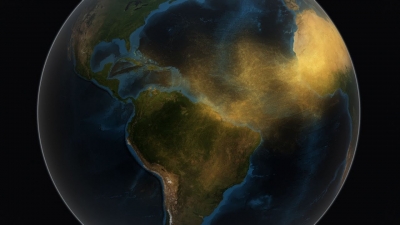
Covering several African countries and an area of more than 90 lakh sq.km., the Sahara Desert is the world’s largest hot desert. Also the largest non-Polar desert, it is bordered by the Atlantic Ocean, the Mediterranean Sea, the Red Sea, and the Niger River. Though a desert, only a part of the region is marked predominantly by sand sheets and dunes, while shallow basins, gravel-rich plains and rocky plateaus make up a huge part of the remaining areas. The region is home to more than two million people and nurtures a variety of plants and wildlife.
Wildlife
The mammals found in the region include the fennec fox, jerboa (a rodent), critically endangered addax (antelope), domesticated camels. gazelles, jackals, hyenas, baboons, and hedgehogs. Amphibians and reptiles include frogs, toads, crocodiles, lizards, snakes, chameleons, and skinks. Among the over 300 resident and migratory bird species found in the Sahara desert are the ostrich, buzzards, kestrels, falcons, kites, eagles, vultures, hawks, harriers, bustards, crakes, coots, geese, grebes, shelducks, ducks, pochards, bitterns, egrets, herons, teals, storks, cormorants, plovers. sandpipers, gulls, terns, sandgrouses, pigeons, doves, cuckoos, owls, nightjars, swifts, bee-eaters, larks, warblers, flycatchers, wheatears, wagtails, pipits, buntings, and sparrows.
Dust storms
Dust storms happen often over dry regions, especially deserts. Usually, tiny grains of sand carried by the wind return to the ground in a matter of hours. But the really tiny ones can remain in the air for a very long time and even be carried thousands of kilometres away through the wind. And that is what happens at the Sahara every year. The dust storms carry minute sand particles as far as the Caribbean, the U.S. and the Amazon region. It can lead to haze, affect the climate, and cause several health issues to humans – from skin problems to asthma. But the dust storm is not without its benefits either. The tiny particles of sand are loaded with nutrients that feed the Amazon. Loaded with phosphorus, potassium, and calcium, the particles fertilise the aquatic and terrestrial ecosystems there.
Did you know?
- Expectedly, climate change is one of the worst threats facing the Sahara. Though it has a harsh terrain and seems inhospitable, the desert has a very fragile ecosystem. Which means, even a slight change-say, an unusual amount of rain during just one season – can drastically alter and affect the balance in the region. This change in the environment would affect the wildlife too.
- The region has the ideal conditions to generate solar energy. “Each square metre receives, on average, between 2.000 and 3.000 kilowatt hours of solar energy per year, according to NASA estimates.” According to Forbes, “We could power the entire world by harnessing solar energy from 1% of The Sahara”. And, Morocco has gotten on with it, thanks to the Noor Complex Solar Power Plant set up in the region. But the question is, is it viable? One of the disadvantages of having solar panels in a place as hot as the Sahara is that when the panels get too hot, their efficiency drops. Only time will tell how feasible this project is.
- Within the Sahara, the number of domestic animals around waterholes is high. During years with good rainfall, the number of livestock increases. Which means, these animals could deplete water and wild vegetation varieties and deny the wild animals a chance at survival.
- Among a number of human activities that threaten the Sahara are development projects and the cutting down of whatever little green cover is present for firewood. This affects perennial vegetation, alters the ecosystem, and eventually increases the area of barren land.
Picture Credit : Google




